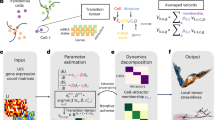Abstract
TRYPSIN is used extensively for dissociation of tissues and in the preparation of suspensions of living cells1. The cell-dissociating effect of this enzyme has been attributed to tryptic degradation of cell binding materials1; however, theoretically, other possibilities exist and the question whether the characteristic enzymatic properties of trypsin are actually involved in cell separation seems not to have been adequately tested, though such information would be of some general interest. Furthermore, since trypsin attacks selectively peptide linkages adjacent to lysyl and arginyl residues, clarification of the relationship between its cell-dissociating activity and its lytic properties would be useful in considerations of the mechanism of cell binding. Trypsin inhibitors offer a direct approach to this matter. It was reported that trypsin inactivated by diisopropylflurophosphate (DFP) did not dissociate adult rat liver cells2. In the work recorded here, the effects of soybean and ovomucoid trypsin inhibitors on the dissociation by trypsin of embryonic tissue were examined. The interaction between these inhibitors and trypsin is considered to be specific and stoichiometric3–5 at concentrations equimolar to and higher than that of the enzyme, the inhibitors rapidly and completely abolish its tryptic activity. According to available results3,5, the molecular weights of trypsin and trypsin inhibitors used in this investigation were of the following order of magnitude: trypsin—24,000; soybean trypsin inhibitor—24,000; ovomucoid trypsin inhibitor—28,000.
This is a preview of subscription content, access via your institution
Access options
Subscribe to this journal
Receive 51 print issues and online access
$199.00 per year
only $3.90 per issue
Buy this article
- Purchase on Springer Link
- Instant access to full article PDF
Prices may be subject to local taxes which are calculated during checkout
Similar content being viewed by others
References
Moscona, A., Exp. Cell Res., 3, 535 (1952).
Easty, G. C., and Mutolo, V., Exp. Cell. Res., 21, 374 (1960).
Desnuelle, P., in The Enzymes, 4, 119 (1960).
Kunitz, M., and Northrop, J. H., J. Gen. Physiol., 19, 991 (1936).
Laskowski, M., and Laskowski, jun., M., Adv. Prot. Chem., 9, 203 (1954).
Moscona, A. A., Exp. Cell Res., 22, 455 (1961).
Green, N. M., J. Biol. Chem., 205, 535 (1953).
Author information
Authors and Affiliations
Rights and permissions
About this article
Cite this article
MOSCONA, A. Inhibition by Trypsin Inhibitors of Dissociation of Embryonic Tissue by Trypsin. Nature 199, 379–380 (1963). https://doi.org/10.1038/199379a0
Issue Date:
DOI: https://doi.org/10.1038/199379a0
This article is cited by
-
On the recovery of adhesiveness by trypsin-dissociated cells
The Journal of Membrane Biology (1973)
-
Dissociation of single cells from lung or kidney tissue with elastase
In Vitro (1972)
-
Trypsin sensitivity of mammalian cells grown in a serum-free medium
In Vitro (1971)
-
Aggregation of sponge cells: Cell-linking macromolecules and their role in the formation of multicellular systems
In Vitro (1967)
Comments
By submitting a comment you agree to abide by our Terms and Community Guidelines. If you find something abusive or that does not comply with our terms or guidelines please flag it as inappropriate.



